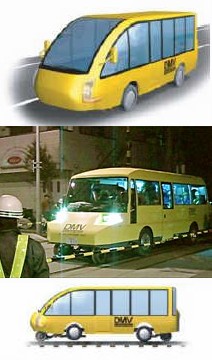 On November 27, Sohgo Security Services (ALSOK) unveiled a new security system that relies on teamwork between robots and human security guards. The system, called Reborg-Q, will be put into action at AquaCity shopping mall in Odaiba (Tokyo) in mid-December.
On November 27, Sohgo Security Services (ALSOK) unveiled a new security system that relies on teamwork between robots and human security guards. The system, called Reborg-Q, will be put into action at AquaCity shopping mall in Odaiba (Tokyo) in mid-December.
The Reborg-Q security robot, which is an upgraded version of ALSOK's Guardrobo D1, weighs 90 kilograms (200 lbs) and measures 130 x 65 x 70 cm. It can be programmed to automatically patrol a preset course, or a joystick can be used to control it remotely. The robot can also be equipped with a function to control elevators, enabling it to move from floor to floor while making its rounds.
While on patrol, four cameras mounted in the robot's head and shoulders record video, and its sensors detect the presence of humans, water leaks and fire. When the robot encounters something suspicious, it alerts a computer in the security room and sends video. Human security guards view the video footage sent by the robot and determine how to respond.
Equipped with communication functions, the robot can also provide services to the people it is watching. A touch-screen embedded in the robot's chest can be used to display information about lost children and other data about the surroundings, and a voice synthesizer enables the robot to tell the time, provide weather data and make promotional announcements.
In addition, a contactless FeliCa card reader embedded in the robot's right shoulder means it can be used to check company IDs and verify the identity of employees at company entranceways. And like Guardrobo D1, Reborg-Q can also be equipped with a fire extinguisher.
Each robot costs about 380,000 yen ($3,200), so the initial cost of a system is in the 1 to 2 million yen ($8,500 to $17,000) range. The company plans to deploy the Reborg-Q system at 10 locations around Japan in 2007.
[Source: Robot Watch]

 A dual-mode vehicle (DMV) that looks like a minibus and runs both on conventional railway tracks and paved roads was tested on the Gakunan railway in Fuji city (Shizuoka prefecture) on the night of November 24. The 28-passenger test vehicle was developed by the Hokkaido Railway Company (JR Hokkaido) in a
A dual-mode vehicle (DMV) that looks like a minibus and runs both on conventional railway tracks and paved roads was tested on the Gakunan railway in Fuji city (Shizuoka prefecture) on the night of November 24. The 28-passenger test vehicle was developed by the Hokkaido Railway Company (JR Hokkaido) in a 




 Hitachi has successfully tested a brain-machine interface that allows users to turn power switches on and off with their mind. Relying on
Hitachi has successfully tested a brain-machine interface that allows users to turn power switches on and off with their mind. Relying on 
 On November 6,
On November 6,  On November 6,
On November 6,  A spacewear fashion show featuring clothing designed for travel in weightless conditions was held at the University of Tokyo's Hongo campus on November 2.
A spacewear fashion show featuring clothing designed for travel in weightless conditions was held at the University of Tokyo's Hongo campus on November 2.